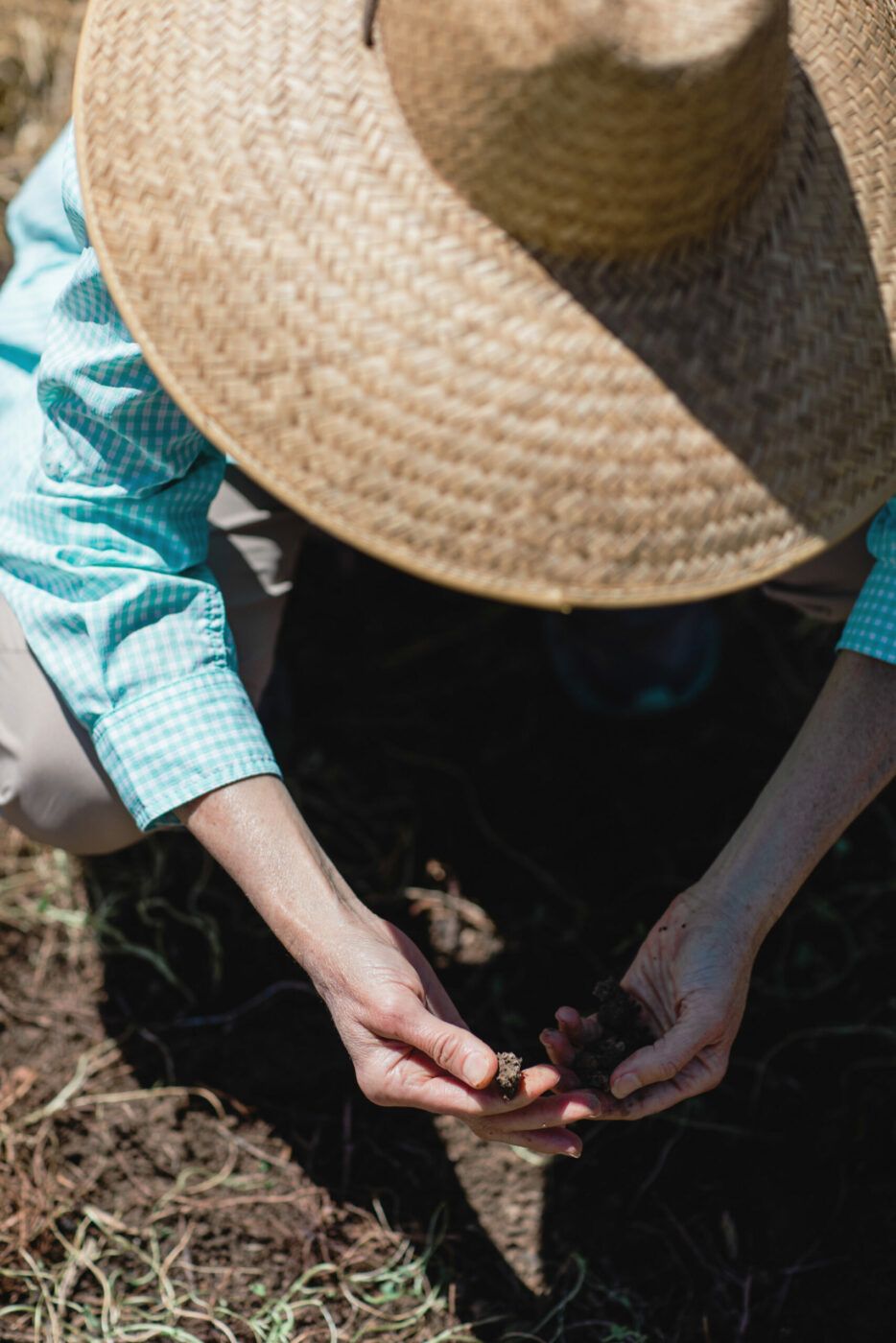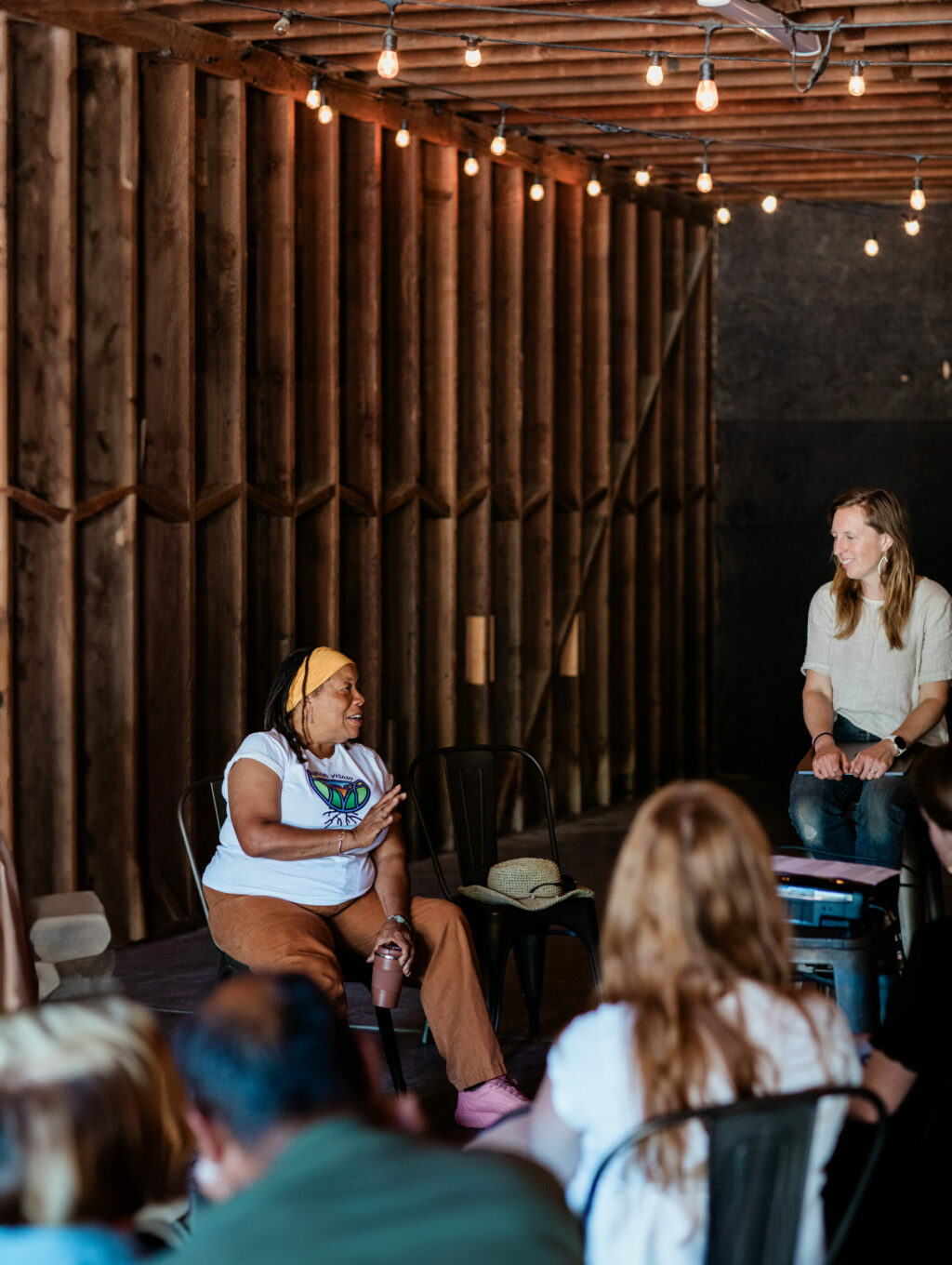The woman standing at the edge of a field of row crops brandishing a large knife was not, in fact, an extra from a “Mad Max” sequel. This was Erika Foster, a soils expert with Point Blue Conservation Science, and on this June morning, Foster and a colleague were leading a workshop on soil health at Climate Farm School, a visionary week-long program that immerses climate leaders of all ages and backgrounds in principles of food policy and hands-on regenerative farming.
Bad-ass though it looked, the knife in Foster’s hand wasn’t especially sharp, or dangerous. It was a traditional Japanese trowel called a hori-hori, one of several tools that Climate Farm School students used to work the soil in this corner of “campus” — the 172-acre Green Valley Farm + Mill outside Sebastopol.
Our assignment that morning was to extract a soil sample, then perform a “field texture assessment,” adding water and making mudballs out of our sample to determine its percentage of sand, silt and clay. Those percentages would tell us much about the soil underfoot.

Watching the mudball experiments go down was the indefatigable Laney Siegner, the founder and co-director of the school and a pioneer in applying “experiential approaches” to climate change education in farm settings. Siegner worked on regenerative farms while earning a Ph.D. at UC Berkeley and explains she was blown away by the hands-on knowledge of the farmers, many of whom had advanced degrees of their own.
The daughter of a teacher, she found herself asking how she could connect others to the wisdom of those who farm the land. Climate Farm School was born, and three years later has two host sites in California — the other is in San Benito County — plus one in the northwest, one each in Vermont and New York state, and a sixth in Italy.
I’d come to the course with scant knowledge of farming, although I did love the E.B. White novel “Charlotte’s Web,” and was profoundly relieved when Wilbur the pig was spared. Beneath my nodding, studious mien on that first morning of school was a hidden cynic wondering: Who were these people, shelling out several thousand dollars to play farmer?
That cynic washed out of Climate Farm School in the first 20 minutes. Any skepticism I’d harbored was replaced with respect for my fellow students, and gratitude for their big brains and willingness to do a deep dive on the planet’s most intractable problems, and determination to solve them.
The school combines online sessions with a week of “getting your hands dirty on a working farm,” according to a course description.

They mean that literally. Out in the field, as we assessed our mudballs, Erika Foster pointed out, “There are more individual organisms in that handful of soil than there are people on the planet. Thousands and thousands of bacteria and fungi, protozoa and archaea, all of the many large classifications of life, are found within soils across the world.”
We saw several of those classifications up close: lots of wriggling worms inconvenienced by our research, along with pill bugs and a millipede.
Greg Richardson, another soil expert from Point Blue, likened the exercise to snorkeling. “You stand at the edge of the water, and it’s choppy, or flat. But it’s not until you put your head underwater that you realize how much is going on.”
The curriculum, devised by Siegner and her co-director, Ryan Peterson, focuses on regenerative agriculture, a philosophy and approach to farming and ranching intended, according to the National Resources Defense Council, “to restore soil and ecosystem health, address inequity and leave our land, waters and climate in better shape for future generations.”
It made sense to start with soil — “the foundation of everything we’ll be doing the rest of the week,” said Siegner.

Richardson had begun that morning’s session by asking us to go around the circle, introducing ourselves and detailing our “background” and “experience.”
In this company, it seemed inappropriate to reply truthfully — Hi, I’m Austin and I once tried to aerate my lawn with a pitchfork but ended up killing it — so I ignored that instruction.
We learned that Nitesh Dullabh, a wise and kind 50-something from Los Altos with a background in “environmental-social-governance issues,” now runs a consultancy, helping businesses and other entities practice “regenerative sustainability.”
Ashwini Ramanathan was visiting from New York City, where she tends a garden on the patio of her apartment and is working towards a master’s degree at Columbia University in sustainability management. She spoke of her keen interest in the “reciprocal relationship” between climate change and agriculture.
“As someone who lives in a large city,” she later shared, “my exposure to farmland and understanding of how my food is grown is limited.”

Carley Hauck, an author, podcaster and Stanford instructor, had been studying regenerative agriculture on her own for the last four years, she told us. She volunteered at Coastal Roots Farm in Encinitas and was interested in someday starting her own farm.
Smiling, effervescent Khadine Singh studied mechanical engineering at Columbia and now lives in San Francisco. A native of Trinidad, she’s in her 11th year at Google.
“My thing is data and people,” she told me, “finding the intersection of how I can use my data and statistical skills and engineering skills to help people.”
For the last four years her work has focused on climate. She’s also deeply interested in food supply and soils, “and I’m super-excited to learn more.”
We were all interested in improving the gardens we maintain at home, or, in my case, in learning how to stop needlessly killing innocent flora. But my classmates also had far more righteous and far-reaching plans. They were widely, deeply read on the problems wrought by a warming planet and had cleared this week on their schedules to learn how to become more effective warriors in the battle to save it.
As a forward-thinking, outside-the-mainstream outfit, Climate Farm School fits comfortably in the continuum of Sonoma County enterprises asking big questions about land use, sustainability and farming practices.
Green Valley Farm + Mill, our home for the week, is a community of farmers sharing land and opportunity. Nearby are EARTHseed Farm, California’s first Afro-Indigenous permaculture farm, Solar Punk Farms, a queer farming collective, and Heron Shadow, a tranquil 7.6-acre property whose founders teach Indigenous farming practices.
Sebastopol is also home to Elizabeth Whitlow, executive director of the Regenerative Organic Alliance, the nonprofit overseeing the Regenerative Organic Certified program for food, fiber and personal care ingredients.

Many who enroll in Climate Farm School arrive with an interest in a career change or pivot, said Siegner. A week on the farm, in the company of experts and like-minded students, usually reinforces that yearning.
Students “have used the course to change and grow,” said Siegner. A few have gone on to start their own regenerative food companies. One specializes in Korean bone broth, another in chickpea pancakes, and two former students teamed up to start a pasta company in Brooklyn.
Siegner and Peterson have plans to scale up the school operation. In addition to their six current sites, they have scoped out a “pipeline” of a half-dozen other farms in Massachusetts, North Carolina, Tennessee and Ireland.
There seems to be no shortage of people thirsty for the kind of hands-on experiences Siegner and Peterson have developed, despite the cost, which is around $3,000 and covers meals and housing for the in-person week at the farm, plus three weeks of online courses and access to a vibrant network of alumni.
Some scholarships are available, which is helpful, said Siegner, “because we have a lot of scholarship need.”
That’s part of the reason Climate Farm School became a nonprofit in March, “so we can fundraise more to support the cost of the course. We don’t want financial access to be a barrier,” she said.
It was fun, going back to school, stretching my brain to retain, for instance, CLORPT. That’s the ungainly word for the five factors which control soil formation: CLimate, Organisms, Relief, Parent material and Time.
“It’s not a very intuitive acronym,” allowed Richardson, after teaching it to us.
The five components of CLORPT are not to be confused with the Five Soil Health Principles embraced by regenerative agriculture adherents, including “reducing disturbance” to avoid breaking up the soil, and “keeping the soil covered” with mulch or a cover crop, to prevent erosion.
Based on the number of times it cropped up, so to speak, the most important soil health principle was plant diversity, an antidote to monoculture crops.
Applying these principles, Richardson says, will “bring the way we farm back into alignment with how natural systems tend to work.”

To better understand how soil-building results in healthier food systems, one morning we traipsed a half-mile to the northern end of the property, where 22-year-old farmer Alice Tibbetts operates a 1.5-acre plot called Fledgling Farm.
The month of June had been intense — “the crunch month,” she told us, between harvesting for her weekly CSA distribution and “big plantings” of melons, winter squash, nightshades and other veggies. “And the weeds are insane.”
She has learned, among other things, to let go of perfection. While much of her produce is beautiful, beetles gnawed holes in some of the chard this season. “So I was like, ‘OK, CSA members, here’s your holey chard. Sorry but not sorry. I tried my best. And it’s still delicious.’”
While the work is hard and unrelenting, Tibbetts told us, she tries to think of it as more of a ritual, “so it doesn’t feel like work, it feels like life practice.”
She was also listening to an audiobook called “Radical Acceptance.”
“It helps me deal with weedy beds.”
It felt good to pitch in alongside her, laying down some mulch, trying my hand at the versatile “scuffle hoe” to root out small weeds, and helping plant Little Gem lettuces between rows of peppers. Tibbets asked that we press down at the base of the lettuces when planting. That would create “good root contact” and a slight depression, where water could pool.
Not long after, I was chagrined to see her revisiting some of the lettuces I’d planted, using her fingers to slightly deepen that pool. “I would love to see a little more impression around the plant, if that makes sense,” she said, addressing no one in particular.
I looked around, as if searching for the culprit, even though that slipshod planter was me.
Later, to a warbling musical score of barn swallows and the occasional, joyous exclamations of Siegner’s 2-year-old daughter, Juniper, co-director Ryan Peterson led a talk on the trillion-plus-dollar bundle of bills, appropriations and regulations now known as the Farm Bill. That massive amalgam of omnibus legislation is passed every five years — in theory. The current Farm Bill expired last September.
Most programs have been extended while legislators haggle over the next version.

We learned about Earl Butz, the agribusiness-friendly Secretary of Agriculture in the early 1970s, who supercharged the movement to industrialize American farms, which vastly increased food production but, in Peterson’s view, has also resulted in a host of ills.
While diversifying their crops could make many farmers better able to withstand natural disasters, pests and diseases, the current Farm Bill incentivizes monocropping, Peterson explained to the group. “So we’ve got an insurance system that pays out in times of low resilience, and at the same time creates low resilience.”
Not gonna lie — it can all get a little heavy, at times, dwelling on climbing temperatures and dysfunctional ag policies and forecasts that global topsoils will deplete in 60 years.
Well aware of this, the course designers allowed some space to address the angst. Since losing her home near the Trinity Alps in a 2021 wildfire, Ana Alanis, a Climate Farm School alumna, has worked to raise awareness around the mental toll of the climate crisis.
“My hope for today,” she said, “is to create some space for the value of climate emotions” — the fear, anger, anxiety and other feelings brought on by climate change. One classmate spoke of a recent, intense conversation she’d had with her husband, who agreed with her that the planet was in trouble but did not agree that this trend could be reversed. She found herself reflecting on “what does that mean for us, for our planet, for our lives, thinking there’s nothing we can do.”
The woman looked forward to grappling with those questions at Climate Farm School, she said, because she was confident “people here would help me work through it. And you have.”
Carley Hauck, the author and self-described “truth-teller,” wasn’t bashful about sharing her opinion that things are going to get much worse before they get better.
“There’s going to be a hell of a lot more suffering before we really wake up and make a lot of changes.” More people will have perished, she predicted, and more species will have died off.
“And I feel rage. Why are we not waking up? Why are we making this so much harder than it has to be?”
She explained that she doesn’t “shush” the part of her that’s in touch with her rage. “I have to move it. I have to pound pillows, swim, yell.” Once she’s past it, she said, “I can move into fierce, compassionate action.”
On the last full day of school, it was time to focus on “models of transformation” designed to give students hope, or at least “pause us from worrying,” explained Siegler. Friday’s model was Wanda Stewart, a highly respected food justice activist, urban farmer, community builder and legendary gardener in the East Bay.
One of her titles now is executive director of Common Vision, a nonprofit committed to planting fruit tree orchards and gardens at low-income schools. Stewart has helped with countless gardens, none more glorious than the sprawling, thriving victory garden at Hoover Elementary School in west Oakland. Starting in 2015, students transformed what had been a dirt patch to a 10,000-square-foot garden space.

In her first week at Hoover, Stewart recalled in 2020, “a sweet first-grade boy was having a temper tantrum. He looked me in the eye and threw the chair across the room. When I asked him why he did that, he said, ‘I’m hungry.’ That’s when we got busy growing food for the kids, to show them they could grow their own food, to incorporate outdoor learning into their world, and most importantly to feed them.”
Food waste, we’d learned, is a global issue with widespread negative effects. Stewart told the story of how she and her allies were addressing it on a local level.
Around the time of the pandemic, the organic grocery delivery service Good Eggs in Oakland found itself in high demand. Business was so good, in fact, that they were discarding large amounts of high-end groceries. “In America, the better a business is doing, the less it cares about the trash it’s throwing away,” said Stewart.
Good Eggs invited Stewart and her fellow volunteers to take that food — sirloin steak, legs of lamb, organic whole chicken — and distribute it as they saw fit. “At first we started giving this food away at the gardens where we worked.” Then they started giving it to local public school students.
“We’re feeding the kids who had the least, the food of those who had the most,” says Stewart. She believes that upgrade in nutrition makes them better students. “Because they’re not coming to class hopped up on what the school district feeds them.”
She has told administrators at the district, “You gotta stop feeding the kids crap now. We’re giving them brioche hot dogs, y’all are giving ’em cardboard.”
To help us truly internalize our lessons on regenerative agriculture, chefs Maggie Cely and Megan Wang — on loan from Brooklyn’s Rule of Thirds restaurant and Saraghina Bakery, respectively — prepared meals with ingredients from Green Valley Farm, including sublime yogurt from the cows who sometimes greeted us but mostly ignored us as we strolled past each morning.
On the final night of farm school, sitting at tables underneath the arbor, Stewart, the food justice warrior, buttonholed Richardson, the Point Blue soil specialist. She was preparing to apply for some grants, and wondered how she might measure carbon sequestration for the school gardens in which she works — “where we’re mulching on top of asphalt.”
“On top of asphalt? I don’t get that,” said Richardson.
“We have large spaces where there’s nothing but asphalt,” Stewart explained. Rather than tear the asphalt out, which is prohibitively expensive, “we put down cardboard and mulch and mulch and mulch across the years.”
Richardson lit up. Now that he understood, he had a number of suggestions, on which he expounded in a quintessentially Climate Farm School exchange.

In the gloaming after dinner, students and instructors sat around a fire pit to reflect. One student said the highlight of the week was hearing of Stewart’s successes in urban school gardens. Her own emerging interest was in how she might get involved in a similar movement near her home in the Northwest, “working with kids, helping them realize how good food can be, where it comes from, and how they can be a part of it.”
“Try Black Futures Farm in Portland,” Stewart suggested from across the table. “And I got a name for you in Washington.”
Khadine Singh, the Google executive from San Francisco, also listed time with Stewart as a highlight. “I think we can’t have this discussion” about reforming systems “without talking about food justice.” Without Stewart’s talk, she said, Climate Farm School would’ve felt incomplete.
Singh said her week on the farm had deepened her connection to the land. “The more we take care of the earth, the more we take care of ourselves,” she said, before adding a sobering note. “The planet’s going to be fine… The earth will right itself. We’re just trying to make sure we can live on it.”



















